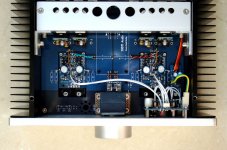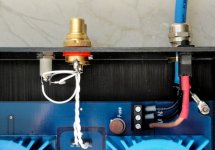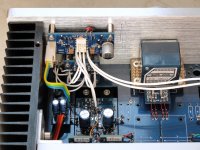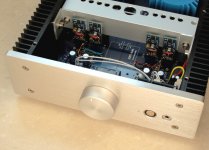There are also caps & resistors in SMD with low distortion :
forum.vegalab.ru/attachment.php?attachmentid=204695&d=1394405380
Low noise surface mount resistors?
I only use Susumu thin film and Beyschlag MELF.
Patrick
forum.vegalab.ru/attachment.php?attachmentid=204695&d=1394405380
Low noise surface mount resistors?
I only use Susumu thin film and Beyschlag MELF.
Patrick
Walt Jung, when asked for advice to those considering their own diy projects:
WALT: I’ll echo advice that Ed Dell expressed years back, on making ice cream, “Always use good stuff!” Works for audio also—good stuff means the highest quality parts one can afford, applied sensibly. Hand-rubbed wood enclosures are also pretty and add a touch of class. That part’s up to the readers. But I’d also add, first pick a good candidate project upon which to lavish the attention!
http://waltjung.org/PDFs/AX_WJ_Interview.pdf , p37
WALT: I’ll echo advice that Ed Dell expressed years back, on making ice cream, “Always use good stuff!” Works for audio also—good stuff means the highest quality parts one can afford, applied sensibly. Hand-rubbed wood enclosures are also pretty and add a touch of class. That part’s up to the readers. But I’d also add, first pick a good candidate project upon which to lavish the attention!
http://waltjung.org/PDFs/AX_WJ_Interview.pdf , p37
As the original protos went to another XEN team member, I just built another pair for myself.
This time I decided to try the CCS bias myself.
Works like a treat.
With no trimming at all DC offset was ~ +30mV on both channels.
Adding a 200k resistor in parallel to R44 reduces that to -2mV.
Stable over half an hour after the initial 2 minutes (from -20mV at cold start).
No servo needed, for me at least.
🙂
Patrick
This time I decided to try the CCS bias myself.
Works like a treat.
With no trimming at all DC offset was ~ +30mV on both channels.
Adding a 200k resistor in parallel to R44 reduces that to -2mV.
Stable over half an hour after the initial 2 minutes (from -20mV at cold start).
No servo needed, for me at least.
🙂
Patrick
Apparently it is difficukt to find Beyschlag MELF resistors in 0.1%.
What you can simply do is buy a bunch 1% or 0.5%, and measure them with a DMM or LCR meter.
They do not need to be exact, they just want to have the same value.
So not 0.1% absolute, but 0.1% match.
Mismatch will just cause some gain deviations between channels, a touch more 2nd harmonics, and some more need for trimming.
Still nothing dramatic.
You can also skip all the hfe matching and just build using transistors off the tape.
Just don't expect -110dB distortion in that case.
😉
Patrick
What you can simply do is buy a bunch 1% or 0.5%, and measure them with a DMM or LCR meter.
They do not need to be exact, they just want to have the same value.
So not 0.1% absolute, but 0.1% match.
Mismatch will just cause some gain deviations between channels, a touch more 2nd harmonics, and some more need for trimming.
Still nothing dramatic.
You can also skip all the hfe matching and just build using transistors off the tape.
Just don't expect -110dB distortion in that case.
😉
Patrick
Apparently it is difficukt to find Beyschlag MELF resistors in 0.1%.
What you can simply do is buy a bunch 1% or 0.5%, and measure them with a DMM or LCR meter.
They do not need to be exact, they just want to have the same value.
So not 0.1% absolute, but 0.1% match.
Mismatch will just cause some gain deviations between channels, a touch more 2nd harmonics, and some more need for trimming.
Still nothing dramatic.
You can also skip all the hfe matching and just build using transistors off the tape.
Just don't expect -110dB distortion in that case.
😉
Patrick
Problem is Patrick that Mouser or Digikey have zero MELF resistors in any tolerance with values 5.1K, 6.2K and 1R.
I cannot find them anywhere, looks like these nice resistors are on their way out too?
Suggest you organise a GB :
Vishay SMD thin-film resistor, 6.2 kΩ (6K2), 0.25 W, TK +-50 MMA 0204-50 BL 1% 6K2 | Burklin Elektronik
Vishay SMD thin-film resistor, 5.1 kΩ (5K1), 0.25 W, TK +-50 MMA 0204-50 BL 1% 5K1 | Burklin Elektronik
Vitrohm SMD metal film resistor, 1 Ω (1R0), 0.25 W, TK +-50 ZC0204FKE07 1R0 | Burklin Elektronik
If you can find 0.25W 1206 thin film with 50ppm/K tempco, it will also do.
I did not manage last time I tried.
Patrick
Vishay SMD thin-film resistor, 6.2 kΩ (6K2), 0.25 W, TK +-50 MMA 0204-50 BL 1% 6K2 | Burklin Elektronik
Vishay SMD thin-film resistor, 5.1 kΩ (5K1), 0.25 W, TK +-50 MMA 0204-50 BL 1% 5K1 | Burklin Elektronik
Vitrohm SMD metal film resistor, 1 Ω (1R0), 0.25 W, TK +-50 ZC0204FKE07 1R0 | Burklin Elektronik
If you can find 0.25W 1206 thin film with 50ppm/K tempco, it will also do.
I did not manage last time I tried.
Patrick
Suggest you organise a GB :
Vishay SMD thin-film resistor, 6.2 kΩ (6K2), 0.25 W, TK +-50 MMA 0204-50 BL 1% 6K2 | Burklin Elektronik
Vishay SMD thin-film resistor, 5.1 kΩ (5K1), 0.25 W, TK +-50 MMA 0204-50 BL 1% 5K1 | Burklin Elektronik
Vitrohm SMD metal film resistor, 1 Ω (1R0), 0.25 W, TK +-50 ZC0204FKE07 1R0 | Burklin Elektronik
If you can find 0.25W 1206 thin film with 50ppm/K tempco, it will also do.
I did not manage last time I tried.
Patrick
You star Patrick, Thank you. Will ask the GB mates if they are interested.
This also appears to be a suitable replacement :
Vishay TNPW e3 series thin film chip resistors
TNPW12065K10BEEA Vishay | Mouser Europe
0.1%, so no matching required.
Patrick
Vishay TNPW e3 series thin film chip resistors
TNPW12065K10BEEA Vishay | Mouser Europe
0.1%, so no matching required.
Patrick
This also appears to be a suitable replacement :
Vishay TNPW e3 series thin film chip resistors
TNPW12065K10BEEA Vishay | Mouser Europe
0.1%, so no matching required.
Patrick
Patrick,
I'm trying to embrace SMD (not withstanding my (prematurely -50yrs) aging eyesight.
May I ask about your selection/suggestion of this specific part?
Vishay advertise its use when the "highest reliability and stability at high operating voltages is of major concern. The series features high operating voltage Umax. up to 1000V"
And of course it's 0.1% tolerance
Thanks,
Steve
For SMD resistors, you wish to look for thin film and low tempco.
Beysclag MMA0204 is known to be good, is 15ppm/K for 0.1%, but is getting expensive.
And I believe it is still made in Germany.
You can also get 1% and do some DC trimming, or hand matching.
The Vishay TNPW1206 is comparable in almost all specifications.
But at Mouser they are a touch more expensive than Beysclag.
I have not used them personally, as I have a healthy stock of Beyschlag at home.
Patrick
Beysclag MMA0204 is known to be good, is 15ppm/K for 0.1%, but is getting expensive.
And I believe it is still made in Germany.
You can also get 1% and do some DC trimming, or hand matching.
The Vishay TNPW1206 is comparable in almost all specifications.
But at Mouser they are a touch more expensive than Beysclag.
I have not used them personally, as I have a healthy stock of Beyschlag at home.
Patrick
Susumu RG SMD are also good thin films:
https://www.mouser.co.uk/datasheet/2/392/n_catalog_partition01_en-1140338.pdf
https://www.mouser.co.uk/Passive-Co...1yzv4jiZ1yzmoty&Keyword=Susumu+RG+SMD&FS=True
https://www.mouser.co.uk/datasheet/2/392/n_catalog_partition01_en-1140338.pdf
https://www.mouser.co.uk/Passive-Co...1yzv4jiZ1yzmoty&Keyword=Susumu+RG+SMD&FS=True
Yes, which is why I specify them for 0805 and 0603.
But very few values in stock at Mouser for 1206.
Patrick
But very few values in stock at Mouser for 1206.
Patrick
A bit of information upfront for the GB2.
The original discrete regulators were designed to use LM329 as voltage reference.
TI has announced EOL now, unfortunately.
The equivalent from Analog Device is rather expensive, but still available.
As an alternative, I have successfully replaced the LM329 with a single red LED (HLMP6000).
It is perhaps not as stable as the LM329 in terms of voltage and output impedance.
But it is at least as good if not better in terms of noise.
In using the HLMP6000, you need to bear in mind :
1) LM329 is effectively a Zener and hence is reverse biased, whereas the LED should be forward biased.
2) R1/R2 values need to be adjusted to suit. For 15V output, start with R1 7.5k, R2 1.3k.
The exact value depends on Vf of the LED, which may vary slightly from batch to batch.
Hope it is clear.
Patrick
The original discrete regulators were designed to use LM329 as voltage reference.
TI has announced EOL now, unfortunately.
The equivalent from Analog Device is rather expensive, but still available.
As an alternative, I have successfully replaced the LM329 with a single red LED (HLMP6000).
It is perhaps not as stable as the LM329 in terms of voltage and output impedance.
But it is at least as good if not better in terms of noise.
In using the HLMP6000, you need to bear in mind :
1) LM329 is effectively a Zener and hence is reverse biased, whereas the LED should be forward biased.
2) R1/R2 values need to be adjusted to suit. For 15V output, start with R1 7.5k, R2 1.3k.
The exact value depends on Vf of the LED, which may vary slightly from batch to batch.
Hope it is clear.
Patrick
As my first proto amp went to another XEN team member, I wanted to build one for myself to keep.
Voltage is +/-18V; bias 160mA, using Didden Regulators.
SHPP is powered by separate 78L18/79L18 regulators.
Input has a 4-pole 3.5mm TRRS in parallel with normal RCA.
Output has 4-pole Lemo 2B sockets, also in parallel with 3.5mm TRRS.
Crossfeed is normal SMD XEN XFD Passive.
Pot is XEN modified ALPS with Susumu thin-film ladder network.
The aluminium top plate of the Breeze 2107 case is replaced by an anti-static tinted acrylic.
When the amp is powered up, the LEDs from the Didden regulators reflects off the aluminium angle to give a warm glow.
😉
Patrick
Voltage is +/-18V; bias 160mA, using Didden Regulators.
SHPP is powered by separate 78L18/79L18 regulators.
Input has a 4-pole 3.5mm TRRS in parallel with normal RCA.
Output has 4-pole Lemo 2B sockets, also in parallel with 3.5mm TRRS.
Crossfeed is normal SMD XEN XFD Passive.
Pot is XEN modified ALPS with Susumu thin-film ladder network.
The aluminium top plate of the Breeze 2107 case is replaced by an anti-static tinted acrylic.
When the amp is powered up, the LEDs from the Didden regulators reflects off the aluminium angle to give a warm glow.
😉
Patrick
Attachments
Hi Patrick,
is there a special reason why you use 4-pole trrs connectors while the amp is single ended?
Is it only because you can use your excisting connectors of your equipment without adapter?
Greetings
Arnd
is there a special reason why you use 4-pole trrs connectors while the amp is single ended?
Is it only because you can use your excisting connectors of your equipment without adapter?
Greetings
Arnd
I always use separate Gnd wires for the two channels for best image separation.
The only point where the two Gnds of L & R channels are connected is at the crossfeed.
They MUST be connected at the crossfeed.
All my headphones have 4-pole connectors, as if they were balanced.
Patrick
The only point where the two Gnds of L & R channels are connected is at the crossfeed.
They MUST be connected at the crossfeed.
All my headphones have 4-pole connectors, as if they were balanced.
Patrick
OK
All my headphones are also wired balanced, so I'll choose balanced connectors too.
Thanks
Arnd
All my headphones are also wired balanced, so I'll choose balanced connectors too.
Thanks
Arnd
You have to be aware that this only makes sense if your amp is completely dual mono.
Like the examples shown here, with separate power supply Gnd, etc.
Patrick
Like the examples shown here, with separate power supply Gnd, etc.
Patrick
Mine is dual mono with one DCSTB for each channel with input Gnd connected to chassis.
Do I have to remove any Gnd connection to chassis? What's about an adapter when using SE wired headphones. Normally the adapters are putting the Gnd wires of both channels together.
Arnd
Do I have to remove any Gnd connection to chassis? What's about an adapter when using SE wired headphones. Normally the adapters are putting the Gnd wires of both channels together.
Arnd
- Home
- Amplifiers
- Headphone Systems
- The Pioneer Super Linear Circuit




